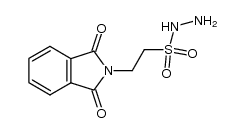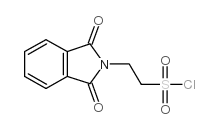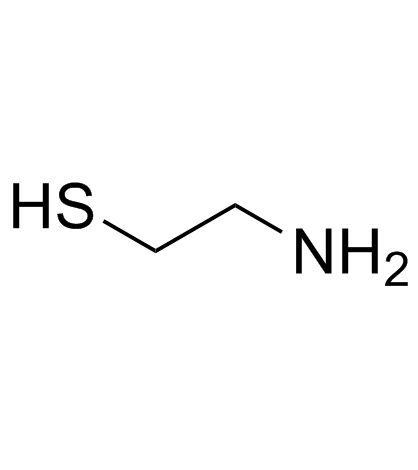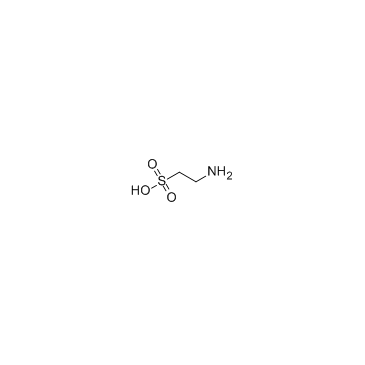300-84-5
| Name | hypotaurine |
|---|---|
| Synonyms |
Ethanesulfinic acid, 2-amino-
2-Aminoethanesulfinic acid 2-Amino-aethansulfinsaeure MFCD00038197 aminoethylsulfinic acid 2-amino-Ethanesulfinic acid 2-aminoethanesulfinate Cystaminesulfinic acid 2-Aminoethylsulfinate 2-Aminoethylsulfinic acid Ethanesulfinic acid,2-amino Hypotaurine Cystaminesulfinate |
| Description | Hypotaurine (2-aminoethanesulfinic acid), an intermediate in taurine biosynthesis from cysteine in astrocytes, is an endogenous inhibitory amino acid of the glycine receptor. |
|---|---|
| Related Catalog | |
| Target |
Human Endogenous Metabolite |
| In Vitro | Hypotaurine and taurine are found to reside within the cytosolic compartment of the cell. The ratio of taurine to hypotaurine is approx 50:1. The cytosolic concentration of taurine is approx. 50 mM. The concentration of hypotaurine decreases by 80% when resting neutrophils are converted into actively respiring cells by exposure to opsonized zymosan[1]. Hypotaurine activates hypoxia signaling through the competitive inhibition of prolyl hydroxylase domain-2. This leads to the activation of hypoxia signaling as well as to the enhancement of glioma cell proliferation and invasion[2]. |
| In Vivo | Hypotaurine has antinociceptive effects on thermal, mechanical, and chemical nociception in the spinal cord. In CCI rats, hypotaurine alleviates mechanical allodynia and thermal hyperalgesia. Intrathecal hypotaurine suppresses acute, inflammatory, and neuropathic pain. Hypotaurine may regulate nociceptive transmission physiologically by activating glycinergic neurons in the spinal cord[3]. |
| Animal Admin | Rats: A radiant heat source is focused on the middle part of the rat’s tail. The time interval from the onset of the stimulus until the tail flick response is measured using a tail flick unit. The intensity of the radiant heat is adjusted to give a tail flick latency of 4–5 s before the administration of hypotaurine or saline. In the absence of a response, the stimulus is terminated after 15 s (cutoff) to prevent tissue damage. The effects of hypotaurine (100, 200, 400, and 600 μg) on thermal nociception are assessed repeatedly for 120 min post-injection[3]. |
| References |
| Density | 1.5±0.1 g/cm3 |
|---|---|
| Boiling Point | 354.9±44.0 °C at 760 mmHg |
| Molecular Formula | C2H7NO2S |
| Molecular Weight | 109.147 |
| Flash Point | 168.5±28.4 °C |
| Exact Mass | 109.019745 |
| PSA | 82.53000 |
| LogP | -2.03 |
| Vapour Pressure | 0.0±1.7 mmHg at 25°C |
| Index of Refraction | 1.616 |
| Storage condition | Desiccate at RT |
| Water Solubility | H2O: 100 mg/mL |
| Symbol |

GHS07 |
|---|---|
| Signal Word | Warning |
| Hazard Statements | H315-H319-H335 |
| Precautionary Statements | P261-P305 + P351 + P338 |
| Personal Protective Equipment | dust mask type N95 (US);Eyeshields;Gloves |
| Hazard Codes | Xi: Irritant; |
| Risk Phrases | R36/37/38 |
| Safety Phrases | S26-S36 |
| RIDADR | NONH for all modes of transport |
| WGK Germany | 3 |
| HS Code | 2930909090 |
|
~% 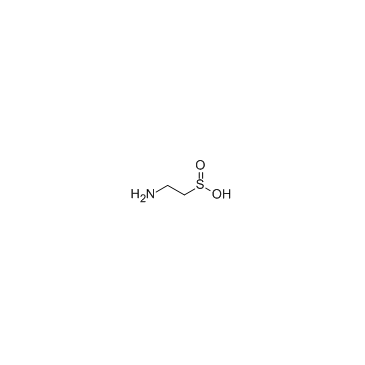
300-84-5 |
| Literature: Journal of the American Chemical Society, , vol. 79, p. 5217,5219 |
|
~% 
300-84-5 |
| Literature: Amino Acids, , vol. 44, # 2 p. 391 - 404 |
|
~% 
300-84-5 |
| Literature: Bulletin de la Societe Chimique de France, , p. 820 |
|
~% 
300-84-5 |
| Literature: Biochemical Preparations, , vol. 10, p. 72 |
|
~% 
300-84-5 |
| Literature: Radiation Research, , vol. 3, p. 393 |
| Precursor 6 | |
|---|---|
| DownStream 4 | |
| HS Code | 2930909090 |
|---|---|
| Summary | 2930909090. other organo-sulphur compounds. VAT:17.0%. Tax rebate rate:13.0%. . MFN tariff:6.5%. General tariff:30.0% |
